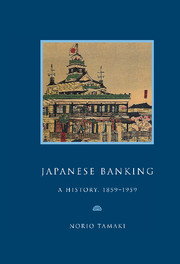Book contents
- Frontmatter
- Contents
- Preface
- Genealogy of leading Japanese banks, 1859–1959
- List of abbreviations
- Map
- Part I A bankrupt Shogunate, 1859–1868
- Part II The Meiji Restoration: monetary confusion and banking experiments, 1868–1881
- Part III Matsukata, the wizard of Japanese banking, 1881–1897; the Yokohama Specie Bank (1880) and the Bank of Japan (1882)
- Part IV The Japanese on the London money market, 1897–1911
- Part V War, the Japanese boom years, 1911–1919
- Part VI Crisis and the road to war, 1919–1937
- Part VII Complete commitment, struggle and defeat, 1937–1945
- Historical background
- 25 War budgets and the mobilisation of national resources, 1937–1943
- 26 Extraordinary banking business during the national emergency, 1941–1945
- 27 Crisis, 1945
- Part VIII American ‘democratisation’ and the search for growth, 1945–1959
- An extraordinary century, 1859–1959
- Appendices
- Notes
- Bibliography
- Index
26 - Extraordinary banking business during the national emergency, 1941–1945
Published online by Cambridge University Press: 03 February 2010
- Frontmatter
- Contents
- Preface
- Genealogy of leading Japanese banks, 1859–1959
- List of abbreviations
- Map
- Part I A bankrupt Shogunate, 1859–1868
- Part II The Meiji Restoration: monetary confusion and banking experiments, 1868–1881
- Part III Matsukata, the wizard of Japanese banking, 1881–1897; the Yokohama Specie Bank (1880) and the Bank of Japan (1882)
- Part IV The Japanese on the London money market, 1897–1911
- Part V War, the Japanese boom years, 1911–1919
- Part VI Crisis and the road to war, 1919–1937
- Part VII Complete commitment, struggle and defeat, 1937–1945
- Historical background
- 25 War budgets and the mobilisation of national resources, 1937–1943
- 26 Extraordinary banking business during the national emergency, 1941–1945
- 27 Crisis, 1945
- Part VIII American ‘democratisation’ and the search for growth, 1945–1959
- An extraordinary century, 1859–1959
- Appendices
- Notes
- Bibliography
- Index
Summary
At the time of the Pearl Harbor attack, there were 194 ordinary banks: in fact, with government encouragement, 230 banks had disappeared since the beginning of the war in July 1937, mainly due to amalgamations and takeovers. The larger banks were considered to be more efficient in making bigger loans, and in supporting market prices of national bonds, the proceeds of which were transferred quickly to the money-hungry munitions industries. Indeed, total amounts of financing for plant investments and for working capital grew in the five years from 1940 to 1945 more than fourfold and sixfold respectively. The most active borrowers were of course machine-tool industries: their investments in plant and working capital financing grew during the same period more than sixfold and twelvefold respectively. More than 70 per cent of these demands was met by ordinary banking which found itself deeply involved in war-related financing.
Ordinary banks were organised as members of the Ordinary Bank Control Association, a section of the Sectoral Control Association. While this was going on, another Ordinance for Financial Business Consolidation, promulgated in May 1942, sought to encourage banks either to merge with each other or to absorb the smaller units. By 1945 there were only sixty-one ordinary banks. There were two notable features in this remarkable amalgamation movement.
At the top level, Mitsui and Daiichi joined together, forming in 1943 Imperial, or Teikoku, Bank. Mitsubishi and Yasuda were also active. As a result, by the end of 1945, there were eight gigantic banks, that is, Yasuda, Imperial, Sanwa, Sumitomo, Mitsubishi, Tokai, Nomura and Kobe Banks.
- Type
- Chapter
- Information
- Japanese BankingA History, 1859–1959, pp. 177 - 179Publisher: Cambridge University PressPrint publication year: 1995

